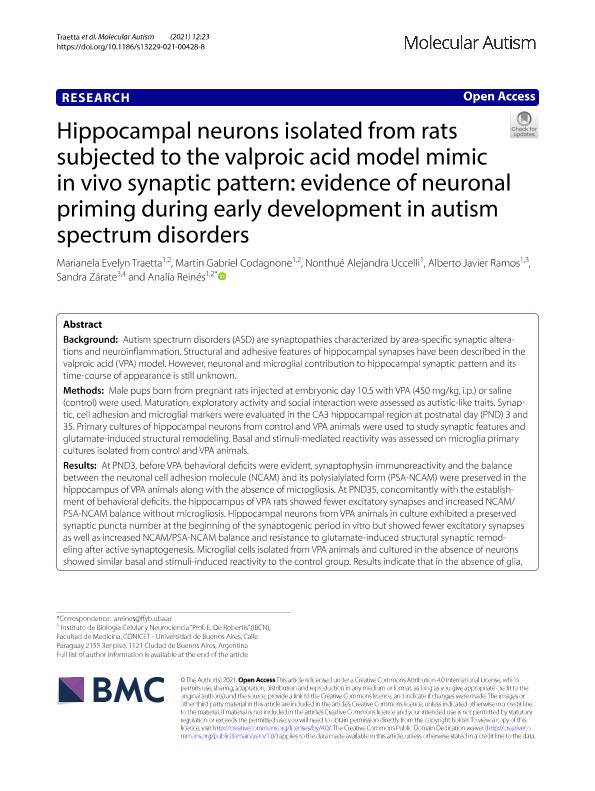Artículo
Hippocampal neurons isolated from rats subjected to the valproic acid model mimic in vivo synaptic pattern: evidence of neuronal priming during early development in autism spectrum disorders
Traetta, Marianela Evelyn ; Codagnone, Martín Gabriel
; Codagnone, Martín Gabriel ; Uccelli, Nonthué Alejandra
; Uccelli, Nonthué Alejandra ; Ramos, Alberto Javier
; Ramos, Alberto Javier ; Zarate, Sandra Cristina
; Zarate, Sandra Cristina ; Reines, Analia Gabriela
; Reines, Analia Gabriela
 ; Codagnone, Martín Gabriel
; Codagnone, Martín Gabriel ; Uccelli, Nonthué Alejandra
; Uccelli, Nonthué Alejandra ; Ramos, Alberto Javier
; Ramos, Alberto Javier ; Zarate, Sandra Cristina
; Zarate, Sandra Cristina ; Reines, Analia Gabriela
; Reines, Analia Gabriela
Fecha de publicación:
12/2021
Editorial:
BioMed Central
Revista:
Molecular Autism
ISSN:
2040-2392
Idioma:
Inglés
Tipo de recurso:
Artículo publicado
Clasificación temática:
Resumen
Background: Autism spectrum disorders (ASD) are synaptopathies characterized by area-specific synaptic alterations and neuroinflammation. Structural and adhesive features of hippocampal synapses have been described in the valproic acid (VPA) model. However, neuronal and microglial contribution to hippocampal synaptic pattern and its time-course of appearance is still unknown. Methods: Male pups born from pregnant rats injected at embryonic day 10.5 with VPA (450 mg/kg, i.p.) or saline (control) were used. Maturation, exploratory activity and social interaction were assessed as autistic-like traits. Synaptic, cell adhesion and microglial markers were evaluated in the CA3 hippocampal region at postnatal day (PND) 3 and 35. Primary cultures of hippocampal neurons from control and VPA animals were used to study synaptic features and glutamate-induced structural remodeling. Basal and stimuli-mediated reactivity was assessed on microglia primary cultures isolated from control and VPA animals. Results: At PND3, before VPA behavioral deficits were evident, synaptophysin immunoreactivity and the balance between the neuronal cell adhesion molecule (NCAM) and its polysialylated form (PSA-NCAM) were preserved in the hippocampus of VPA animals along with the absence of microgliosis. At PND35, concomitantly with the establishment of behavioral deficits, the hippocampus of VPA rats showed fewer excitatory synapses and increased NCAM/PSA-NCAM balance without microgliosis. Hippocampal neurons from VPA animals in culture exhibited a preserved synaptic puncta number at the beginning of the synaptogenic period in vitro but showed fewer excitatory synapses as well as increased NCAM/PSA-NCAM balance and resistance to glutamate-induced structural synaptic remodeling after active synaptogenesis. Microglial cells isolated from VPA animals and cultured in the absence of neurons showed similar basal and stimuli-induced reactivity to the control group. Results indicate that in the absence of glia, hippocampal neurons from VPA animals mirrored the in vivo synaptic pattern and suggest that while neurons are primed during the prenatal period, hippocampal microglia are not intrinsically altered. Conclusions: Our study suggests microglial role is not determinant for developing neuronal alterations or counteracting neuronal outcome in the hippocampus and highlights the crucial role of hippocampal neurons and structural plasticity in the establishment of the synaptic alterations in the VPA rat model.
Palabras clave:
ADHESION MOLECULES
,
AUTISM SPECTRUM DISORDERS
,
HIPPOCAMPUS
,
NCAM
,
SYNAPSE
,
VPA MODEL
Archivos asociados
Licencia
Identificadores
Colecciones
Articulos(IBCN)
Articulos de INST.DE BIOLO.CEL.Y NEURCS."PROF.E.DE ROBERTIS"
Articulos de INST.DE BIOLO.CEL.Y NEURCS."PROF.E.DE ROBERTIS"
Articulos(INBIOMED)
Articulos de INSTITUTO DE INVESTIGACIONES BIOMEDICAS
Articulos de INSTITUTO DE INVESTIGACIONES BIOMEDICAS
Citación
Traetta, Marianela Evelyn; Codagnone, Martín Gabriel; Uccelli, Nonthué Alejandra; Ramos, Alberto Javier; Zarate, Sandra Cristina; et al.; Hippocampal neurons isolated from rats subjected to the valproic acid model mimic in vivo synaptic pattern: evidence of neuronal priming during early development in autism spectrum disorders; BioMed Central; Molecular Autism; 12; 1; 12-2021; 1-23
Compartir
Altmétricas



